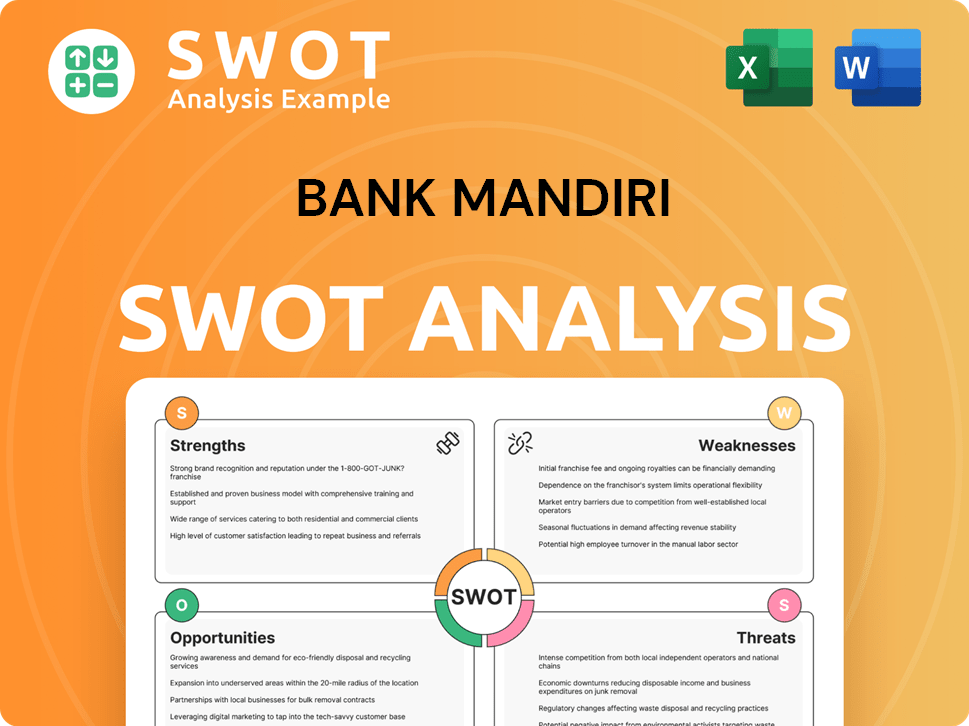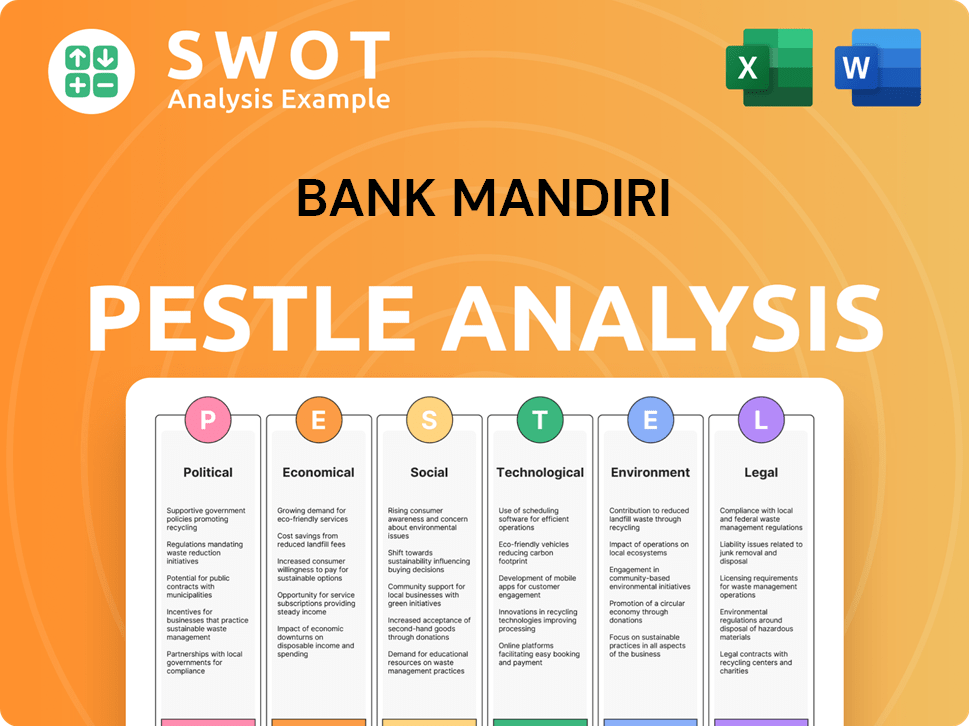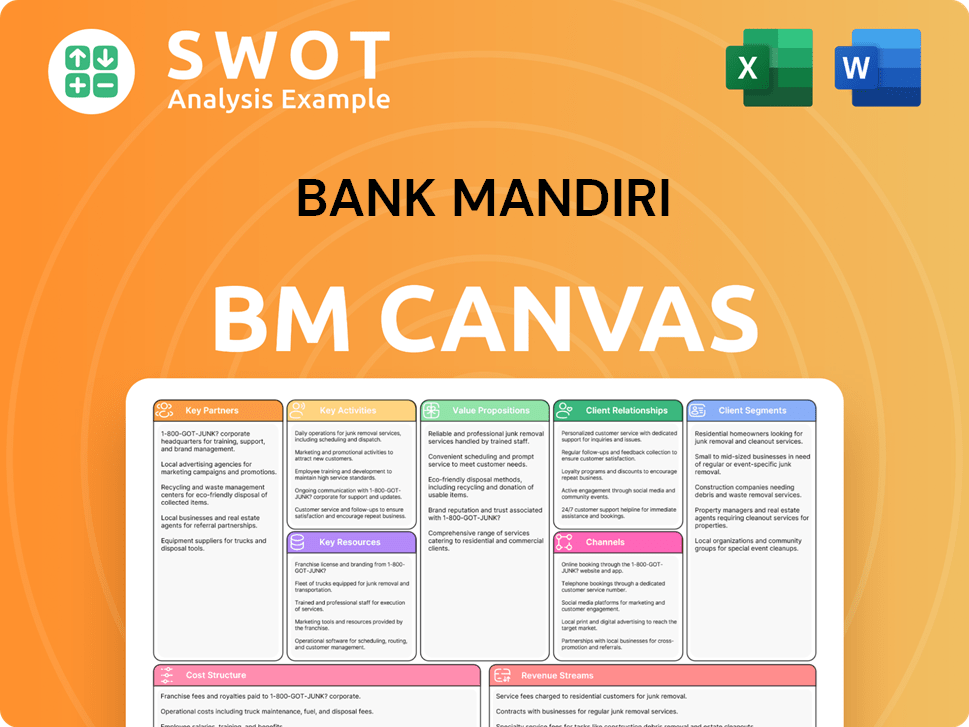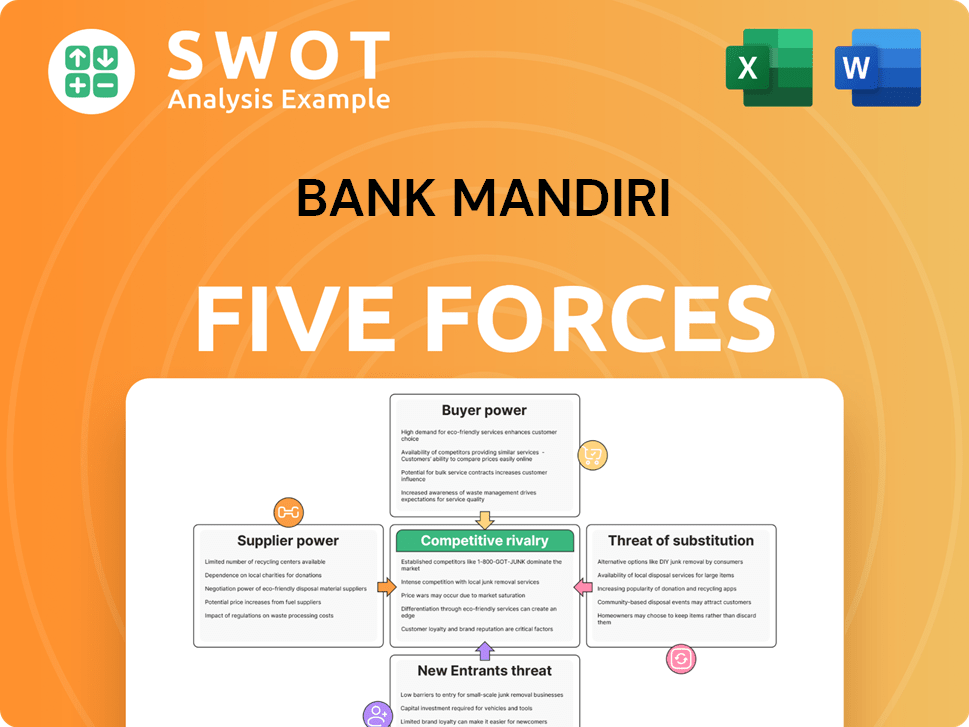Bank Mandiri Bundle
How Did Bank Mandiri Rise to Become Indonesia's Banking Giant?
In the tumultuous aftermath of the Asian Financial Crisis, a new financial titan was forged: Bank Mandiri. Its story is one of strategic consolidation and remarkable growth, born from the ashes of economic turmoil in 1998. This Bank Mandiri SWOT Analysis offers a deeper look into the company's current standing. From its inception, Bank Mandiri has been a cornerstone of the Indonesian banking sector.

This article will explore the brief history of Bank Mandiri, from its founding date to its current status as Indonesia's largest financial institution. Understanding the Bank Mandiri background reveals a story of resilience and strategic adaptation within the Indonesian banking landscape. We will examine its key milestones, the evolution over time, and its impact on the Indonesian economy, providing a comprehensive Mandiri Bank overview.
What is the Bank Mandiri Founding Story?
The Bank Mandiri history begins on October 2, 1998. It was established in response to the 1997-1998 Asian financial crisis that significantly impacted Indonesia's banking sector. The Indonesian government initiated a restructuring program, leading to the merger of four state-owned banks.
This consolidation aimed to create a stronger financial institution. The goal was to restore public confidence and support the country's economic recovery. The founders were the Indonesian government and experts who managed the merger. Their vision was to create a robust financial entity to drive national development.
The initial business model involved using the combined assets and customer bases of the merged banks. This allowed for a wide range of financial services, from retail to corporate banking. This approach catered to various segments of the Indonesian economy. The first 'product' was the unified banking operations under the new name, providing continuous services to millions of customers from the four predecessor banks.
Bank Mandiri's establishment was a direct response to the 1997-1998 Asian financial crisis, leading to the merger of four state-owned banks.
- Founding Date: October 2, 1998
- Merger Banks: Bank Bumi Daya, Bank Dagang Negara, Bank Exim, and Bank Pembangunan Indonesia
- Primary Goal: To create a stronger, more efficient bank to restore confidence and support economic recovery.
- Initial Business Model: Leverage combined assets to offer comprehensive financial services.
A major challenge during establishment was integrating the different systems and cultures of the four banks. This integration occurred amidst a turbulent economic environment. By the end of 2023, the bank's total assets reached approximately IDR 2,165 trillion, reflecting significant growth since its inception. The bank's net profit for 2023 was approximately IDR 51.4 trillion, demonstrating its financial strength and resilience in the Indonesian banking sector.
Bank Mandiri SWOT Analysis
- Complete SWOT Breakdown
- Fully Customizable
- Editable in Excel & Word
- Professional Formatting
- Investor-Ready Format

What Drove the Early Growth of Bank Mandiri?
The early growth phase of Bank Mandiri, a key player in Indonesian banking, centered on consolidating operations and broadening service offerings. Following its establishment in 1998, the bank initiated a strategic transformation. Early product launches and service enhancements targeted both retail and corporate clients, laying the foundation for future expansion.
By 2024, the bank's strategy was centered around 'Growth through Digital and Ecosystem Synergy.' This focused on integrated banking across retail, SME, and corporate segments. The bank prioritized ecosystem-based lending and product bundling. Sector-specific initiatives in energy, construction, and agriculture were key.
Consolidated loans grew by 12.3% to USD 86.3 billion (IDR 1,421.3 trillion) in 2024. This growth reflected a balanced approach across corporate, commercial, and micro segments. Loan growth reached 20.7% in 2024, outpacing the industry's 10.4%.
Digital platforms played a crucial role in Bank Mandiri's expansion. The super app, Livin' by Mandiri, had 29.3 million users in 2024, with 3.9 billion transactions, a 38% increase. The Kopra by Mandiri platform saw transaction values reach Rp22,700 trillion, growing 17% year-on-year in 2024.
Digital initiatives drove growth in low-cost funds (CASA), which contributed 80.3% of total Third Party Funds (DPK) in 2024. These strategic decisions, including digital transformation and ecosystem synergy, allowed Bank Mandiri to maintain market leadership. The bank's focus on these areas significantly shaped its trajectory.
Bank Mandiri PESTLE Analysis
- Covers All 6 PESTLE Categories
- No Research Needed – Save Hours of Work
- Built by Experts, Trusted by Consultants
- Instant Download, Ready to Use
- 100% Editable, Fully Customizable

What are the key Milestones in Bank Mandiri history?
The Bank Mandiri history is marked by significant achievements and strategic pivots within the Indonesian banking sector. From its inception to its current status, the financial institution has consistently evolved, adapting to market changes and technological advancements while playing a crucial role in national development.
| Year | Milestone |
|---|---|
| 1998 | Established through the merger of four state-owned banks: Bank Bumi Daya, Bank Dagang Negara, Bank Ekspor Impor Indonesia, and Bank Pembangunan Indonesia. |
| 2003 | Completed its initial public offering (IPO), marking a significant step in its corporate journey. |
| 2024 | Livin' by Mandiri had garnered 29.3 million users with total transactions reaching 3.9 billion, a 38% increase year-on-year. |
| 2024 | Kopra by Mandiri's transaction values reached Rp22,700 trillion, growing 17% year-on-year. |
Bank Mandiri has demonstrated a strong commitment to innovation, particularly in digital transformation. This focus has led to the development of advanced platforms and the integration of cutting-edge technologies.
The development of Livin' by Mandiri, a flagship super app, has significantly enhanced customer experience and transaction volumes. This platform has become central to the bank's digital strategy.
Kopra by Mandiri, a wholesale banking platform, has driven substantial growth in transaction values. This platform supports the bank's value chain expansion.
AI-driven recommendations in Livin' enhance user experience by providing personalized services. This personalization strategy boosts customer engagement.
Machine learning models are integrated into transaction monitoring systems to detect and prevent fraud. This enhances the security of financial transactions.
Despite consistent growth, Bank Mandiri has faced various challenges, including market competition and economic pressures. The bank's strategic responses and future plans reflect its commitment to sustainable growth and adaptation.
The bank has navigated a tight liquidity environment across the system, requiring strategic financial management. This has influenced the bank's operational strategies.
Intense competition in digital banking poses an ongoing challenge, requiring continuous innovation and customer-centric strategies. This competition drives the need for enhanced digital offerings.
In Q4 2024, net profit increased by 1.3% year-on-year to Rp 55.8 trillion, while total revenue rose by 5.73% to Rp 146.6 trillion. The stock price faced a 2.64% fall in market trading following the Q4 2024 earnings report.
The bank focuses on expanding ecosystem banking, accelerating SME digitization, and consolidating its regional presence. These strategies enhance market reach and customer engagement.
Bank Mandiri is embedding ESG principles into financing decisions and operational practices. The bank has committed to achieving carbon neutrality in its operations by 2030 and in financed activities by 2060.
Bank Mandiri Business Model Canvas
- Complete 9-Block Business Model Canvas
- Effortlessly Communicate Your Business Strategy
- Investor-Ready BMC Format
- 100% Editable and Customizable
- Clear and Structured Layout

What is the Timeline of Key Events for Bank Mandiri?
The Marketing Strategy of Bank Mandiri is underpinned by a rich history of strategic adaptations and significant growth, reflecting its pivotal role in the Indonesian banking sector. Since its inception, Bank Mandiri has navigated the complexities of the financial landscape, continually evolving to meet the demands of a dynamic market. This journey is marked by key milestones, from its formation through mergers to its current status as a leading financial institution.
| Year | Key Event |
|---|---|
| 1998 | Bank Mandiri was established through the merger of four state-owned banks. |
| 2022 | Net profit grew by 61.7% year-over-year (YoY) in the first semester, driven by the 'Leveraging Digital Ecosystem' strategy. |
| 2023 | Bank Mandiri emphasized optimal liquidity management and accelerated digital initiatives. |
| 2024 | Consolidated net profit reached Rp55.8 trillion, a 1.3% increase year-on-year, with total consolidated assets reaching Rp2,427 trillion, an increase of 11.6% compared to the previous year; loan growth reached 20.7%. |
| 2024 | Bank Mandiri strengthened its strategic national footprint by becoming a central player in Danantara, Indonesia's newly launched sovereign wealth superholding. |
| December 2024 | Non-performing loan (NPL) ratio at 1.12% and loan at risk (LaR) ratio at 6.76%. NPL coverage at 271%. |
| March 2025 | Total assets reached IDR 2,463.66 trillion, with a net income of IDR 14.53 trillion for Q1 2025. |
| January 2025 | Bank Indonesia cut its reference rate by 25 basis points to 5.75%. |
| 2025 | Projected to overtake Bank Rakyat Indonesia (BRI) as the country's most profitable bank by net earnings, with a forecasted net profit of Rp 60.3 trillion. |
Bank Mandiri aims for a loan growth target of 10-12% in 2025. The bank is focused on maintaining a net interest margin (NIM) between 5-5.2% and expects the cost of credit to normalize between 1-1.2%. These targets reflect the bank's commitment to sustainable financial performance and strategic growth.
Bank Mandiri's 2025 business plan focuses on expanding ecosystem banking, accelerating SME digitization, and consolidating its regional presence. Key objectives include embedding ESG principles into financing decisions and operational practices, with a target of 15% loan growth led by productive sectors. The bank also aims for net zero emissions in its operations by 2030 and in financed activities by 2060.
The bank is concentrating on expanding transactional CASA and value chain growth. A Return on Equity (ROE) above 20% is a key performance indicator. This strategic focus supports Bank Mandiri's broader goals of fostering economic development and strengthening its market position.
Bank Mandiri is committed to environmental sustainability, targeting net-zero emissions in its operations by 2030 and in financed activities by 2060. This commitment aligns with global sustainability goals and underscores the bank's dedication to responsible financial practices. This commitment is a core part of Bank Mandiri's long-term strategy.
Bank Mandiri Porter's Five Forces Analysis
- Covers All 5 Competitive Forces in Detail
- Structured for Consultants, Students, and Founders
- 100% Editable in Microsoft Word & Excel
- Instant Digital Download – Use Immediately
- Compatible with Mac & PC – Fully Unlocked

Related Blogs
- What is Competitive Landscape of Bank Mandiri Company?
- What is Growth Strategy and Future Prospects of Bank Mandiri Company?
- How Does Bank Mandiri Company Work?
- What is Sales and Marketing Strategy of Bank Mandiri Company?
- What is Brief History of Bank Mandiri Company?
- Who Owns Bank Mandiri Company?
- What is Customer Demographics and Target Market of Bank Mandiri Company?
Disclaimer
All information, articles, and product details provided on this website are for general informational and educational purposes only. We do not claim any ownership over, nor do we intend to infringe upon, any trademarks, copyrights, logos, brand names, or other intellectual property mentioned or depicted on this site. Such intellectual property remains the property of its respective owners, and any references here are made solely for identification or informational purposes, without implying any affiliation, endorsement, or partnership.
We make no representations or warranties, express or implied, regarding the accuracy, completeness, or suitability of any content or products presented. Nothing on this website should be construed as legal, tax, investment, financial, medical, or other professional advice. In addition, no part of this site—including articles or product references—constitutes a solicitation, recommendation, endorsement, advertisement, or offer to buy or sell any securities, franchises, or other financial instruments, particularly in jurisdictions where such activity would be unlawful.
All content is of a general nature and may not address the specific circumstances of any individual or entity. It is not a substitute for professional advice or services. Any actions you take based on the information provided here are strictly at your own risk. You accept full responsibility for any decisions or outcomes arising from your use of this website and agree to release us from any liability in connection with your use of, or reliance upon, the content or products found herein.